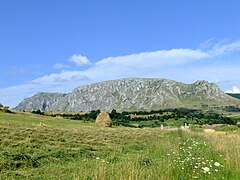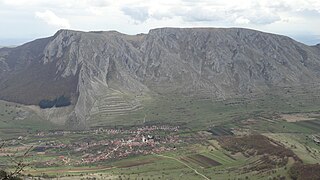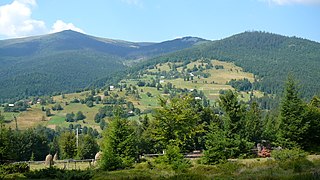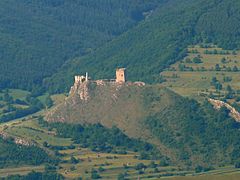Apuseni Mountains



The Apuseni Mountains (Romanian: Munții Apuseni, lit. transl. 'Western Mountains'; Hungarian: Erdélyi-középhegység, transl. 'Transylvanian Mountains') is a mountain range in Transylvania, Romania, which belongs to the Western Romanian Carpathians. The highest peak is the Bihor Peak at 1,849 metres (6,066 ft). The Apuseni Mountains have about 400 caves.
Geography
[edit]The Apuseni Mountains do not present an uninterrupted chain of mountains, but possess many low and easy passes towards the Crișana and the Pannonian Plain. Going from south to north the principal groups are: the Munții Metaliferi ("Ore Mountains") with the basaltic masses of the Detunata (1,148 metres (3,766 ft)) near Abrud; the Bihor Mountains, with numerous caverns, with the highest peak the Bihorul (1,849 metres (6,066 ft));[1] to the east of this group are the Muntele Mare (highest peak 1,820 metres (5,970 ft)), to the southwest of Cluj-Napoca; the northernmost chain is the Seș and Meseș Mountains.
Boundaries
[edit]- To the north: the Barcău River.
- To the south: the Mureș River.
- To the east: the Transylvanian Plateau.
- To the west: the Crișana plains.
Subdivisions
[edit]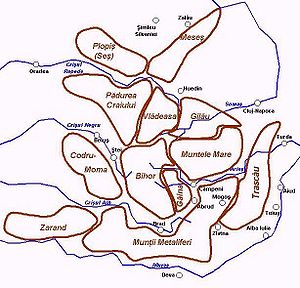

- Criș Mountains (Munţii Crișului, Hungarian: Körös-menti hegyvidék) :
- Criș Hills (Dealurile Crișene, Hungarian: Körös-menti dombság), including the Beiuș Depression (Depresiunea Beiuș, Hungarian: Belényesi-medence) and the Vad Depression (Depresiunea Vad, Hungarian: Révi-medence)[2]
- Pădurea Craiului Mountains (literally:Forest of the King, Hungarian: Királyerdő-hegység)
- Codru-Moma Mountains (Munții Codru-Moma, Hungarian: Béli-hegység)[3]
- Seș-Meseș Mountains (Munții Seș-Meseșului):
- Meseș Mountains (Munții Meseșului, Hungarian: Meszes-hegység)
- Seș Mountains (Muntele Seș, Hungarian: Réz-hegység, also Plopiș)
- Șimleu Depression (Depresiunea Șimleu Silvanei, Hungarian: Szilágysomlyói-medence), often considered part of the Transylvanian Basin-Podişul Someşan
- Șimleu Mountains (Munții Șimleu, Hungarian: Szilágysági-dombvidék), often considered part of the Transylvanian Basin-Podişul Someşan[4]
- Bihor Massif (Masivul Bihor, Hungarian: Bihari-havasok):
- Bihor Mountains (Munții Bihorului, Hungarian: Bihar-hegység)
- Vlădeasa Mountains (Munții Vlădeasa, Hungarian: Vlegyásza-hegység)
- Muntele Mare Mountains (literally: Big Mountain), (Munții Muntele Mare, Hungarian: Öreghavas)
- Gilău Mountains (Munții Gilăului, Hungarian: Gyalui-havasok)
- Mureș Mountains (Munții Mureșului, Hungarian: Marosmenti-hegyvidék):
- Zarand Mountains (Munții Zarandului, Hungarian: Zarándi-hegység)
- Metalliferous Mountains (Munții Metaliferi, Hungarian: Erdélyi-érchegység)
- Trascău Mountains (Munții Trascăului, Hungarian: Torockói-hegység)
Gallery
[edit]- Vlădeasa
- Piatra Secuiului
- Cheile Turzii
- Arieșeni
- Cetatea Trascăului
See also
[edit]References
[edit]- ^ "Geografia Fizică a României" (PDF). Editura Universitară. p. 218. Archived from the original (PDF) on 5 June 2019. Retrieved 5 June 2019.
- ^ "Románia Földrajza". Ordogborda.hu. Archived from the original on 2013-04-19. Retrieved 2013-02-22.
- ^ "GEOGRAPHICAL REGISTER - TRANSYLVANIA (Rumania)". Archived from the original on 2009-01-05. Retrieved 2009-01-27.
- ^ "HAJDÚ-MOHAROS JÓZSEF (1957 2001) HEVESI ATTILA HORVÁTH ZSOLT A Kárpát Pannon térség természeti tájbeosztása". Lazarus.elte.hu. Archived from the original on 2012-02-12. Retrieved 2013-02-22.
External links
[edit]- (in Romanian) Photos from Apuseni Mountains
- (in Romanian) Tourist attractions in Apuseni Mountains
- Website with information about the Carpathians Mountains
- Apuseni Mountains - photographs + information in Czech
- Pictures of the Apuseni Mountains
- Awarded "EDEN - European Destinations of Excellence" non-traditional tourist destination 2009
- Drone views of the Apuseni Mountains on YouTube


 French
French Deutsch
Deutsch
